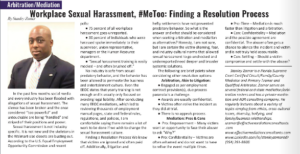Workplace Sexual Harassment: #MeToo & Finding A Resolution Process
#METOO Trends and Highlights
IN the past few months social media and every industry has been a flooded with allegations of sexual harassment. The silence has been broken, and the once considered “too powerful” and untouchable are being “handled” and striped of their positions/power. Sexual harassment is not industry specific, it is not new and the skeletons in the Walmart-size closets are busting out. Here are some statistics from the U.S. Equal Employment Opportunity Commission and news polls:
- 75% of all workplace harassment goes unreported.
- 30% of individuals who were harassed spoke immediately to their supervisor, union representative, managers or the Human Resource department.
- “…sexual harassment training is easily mocked – and often brushed off…”
- According to the Washington Post “between 1997 and 2014 the US Treasury” paid 235 awards and settlements worth approximately $15.2 million for workplace violations on Capitol Hill.
No industry is safe from sexual predatory behavior. And the behavior has been allowed to permeate the business/entertainment/ culture. Even the EEOC states that yearly training is not enough and is usually only focused on avoiding legal liability. After doing many EEOC mediations which lead to reviewing thousands of employment manual pages, state and federal rules, regulations, and policies, I am comfortable to say that there remains to be A LOT of work done if we wish to change the sexual harassment culture.
Finding a Resolution Process
We know that victims are ignored and paid off; and litigation and hefty settlements have not prevented predatory behavior. So what is the answer, and what should be considered when seeking arbitration and mediation as alternatives? Honesty, I am not sure, but I am confident that the Victim-shaming, fear, and the industry-cultural norms that allowed sexual harassment to go unchecked and underreported need deeper and broader systemic solutions.
The following are brief points when considering other resolution options:
Arbitration, Akin to Litigation –
- Engaged as per employment contract provision(s), due process paranoia is a challenge.
- Awards are usually confidential.
- Victims often relive the incident like at a trial.
- No appeals process.
Mediation – Pros & Cons (limited and not exhaustive)
- Pro- Empowerment- Many victims want an opportunity to face their abuser and ask “Why?”
- Pro: Confidentiality- Victims are often ashamed and do not want, to have to relive the event multiple times.
- Pro: Time – Much faster than litigation and arbitration.
- Con: Confidentiality – Mediation and the possible agreement, are confidential. The abuser often gets a chance to silence the incident/victim and is not truly held accountable.
- Con: To Settle – Should a victim compromise and settle with the abuser?
Stanley Zamor is a Florida Supreme Court Certified Circuit/Family/County Mediator & Primary Trainer and Qualified Arbitrator. Mr. Zamor serves on several federal and state mediation/arbitration rosters and has a private mediation and ADR consulting company. He regularly lectures on a variety of topics from ethics, cross-cultural issues, diversity, bullying, and Family/Business relationships.
szamor@effectivemediationconsultants.com
www. effectivemediationconsultants.com
www.LinkedIn.com/in/stanleyzamoradr
(954) 261-8600


